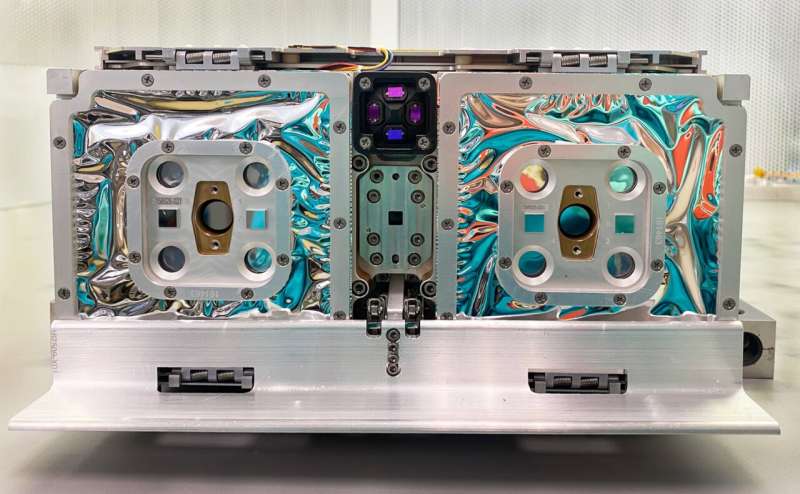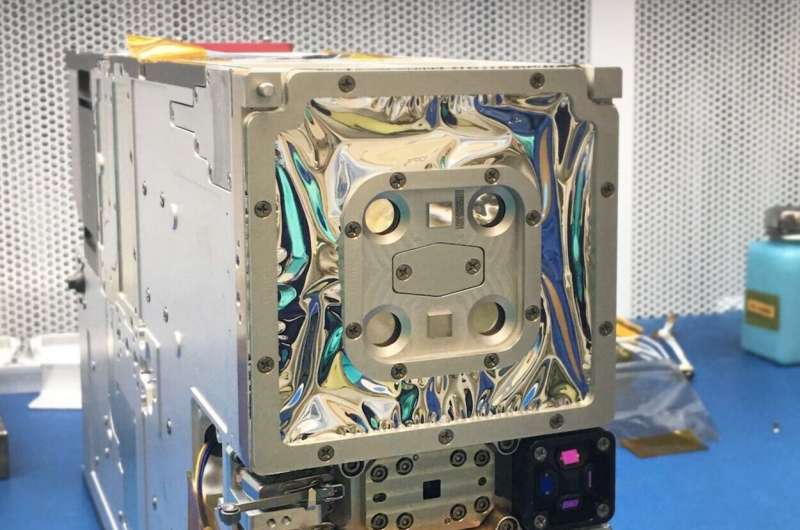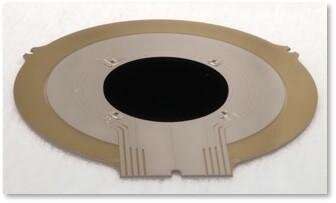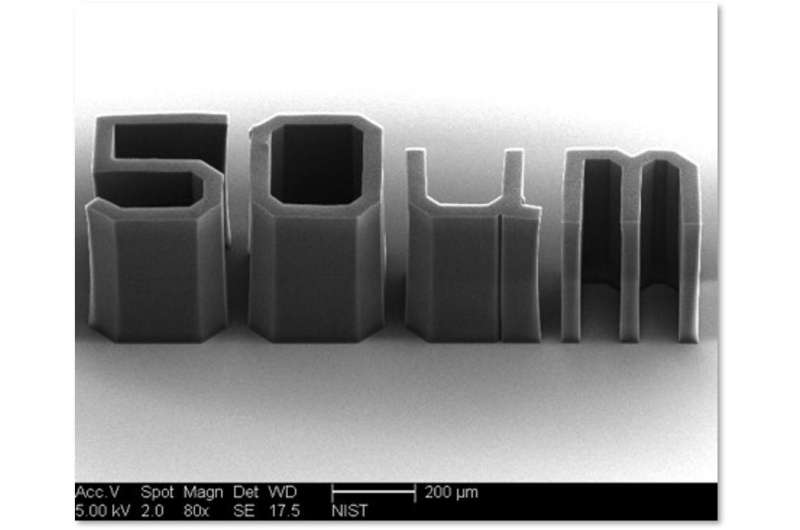Measuring sunlight from space, on a chip

For 40 years, people have used space-based sensors to measure the amount of light coming from the sun, which gives scientists insight into climate change on Earth.
Most of the energy powering Earth's climate system comes from sunlight. So, if scientists measure the energy hitting Earth from the sun, and also measure the energy leaving Earth, then they can determine how much energy remains behind.
Scientists measure the sunlight reaching Earth from space. The quantity they are measuring—called the "total solar irradiance" (TSI)—includes all the energy from all the different wavelengths of light coming out of the sun, from ultraviolet through visible and into infrared.
However, the devices currently being used to monitor the TSI are comparatively expensive to build and launch. This puts at risk the ability of scientists to maintain a continuous, uninterrupted measurement, which they need in order to accurately assess changes to the TSI over time.
Now, new technology developed by the National Institute of Standards and Technology (NIST), in coordination with the Laboratory for Atmospheric and Space Physics (LASP), has made it possible to build and launch a lighter, cheaper device that is as accurate as a comparable instrument currently being used for TSI measurements. Called the Compact Total Irradiance Monitor (CTIM), the instrument is a type of radiation meter integrated into a chip and launched into space on a standardized miniature satellite called a CubeSat.
The NIST chip-based CTIM should give researchers high accuracy (with uncertainties of just 0.015%) and stability (with a drift—a shift in measured values over time—of less than 0.001% per year).

This is comparable to the irradiance monitor currently in use to measure sunlight. However, the new sensor is a tenth of the cost to build, and that's not including the savings from launching a much smaller detector into space.
"This satellite was conceived, built, tested, and launched within a few years, whereas the predecessor took 20 years," said NIST's John Lehman. "We consider that to be a big technical success. There are no commercial detectors that can do this."
The prototype detector was launched this summer and will collect data for two years.
"At this point, the primary detectors have experienced over 100 hours of direct solar exposure since the CTIM CubeSat started taking measurements," says Dave Harber, a senior researcher at the University of Colorado, Boulder, LASP and principal investigator for CTIM. "The CTIM team is currently finalizing the analysis of the data taken so far, but initial analysis shows that the instrument in general, and the NIST fabricated detectors in particular, are exhibiting excellent on-orbit performance."
Newfangled nanotubes
Both the old and new TSI measurements are done with bolometers—detectors that measure incoming optical radiation from the heat it produces. Light from the sun hits the bolometer, which absorbs the optical energy from a range of wavelengths. The absorbed energy heats up a thermometer.

But this heat isn't measured directly. Instead, these devices typically use the principle of electrical substitution. A built-in heater raises the temperature of the thermometer a certain arbitrary amount. Then a shutter opens to reveal the sunlight. The optical radiation from the sun heats the thermometer, and a feedback mechanism causes the heater to back off, in order to keep the temperature constant. How much the heater's power decreases tells you how much optical power from the sun was absorbed to heat the device.
The TSI device currently in use—attached to the International Space Station—is called the Total and Spectral Solar Irradiance Sensor (TSIS). It is relatively heavy and large, almost the size of a dorm fridge, making it more expensive to send to space.
By contrast, the new NIST-LASP TSI instrument is, in total, the size of a shoe box. It collects solar energy with tiny, chip-scale devices, each about the size of a dollar coin, featuring an ultra-absorptive material made of vertically aligned carbon nanotubes (CNTs). These CNTs absorb essentially all visible light as well as most light in the ultraviolet (UV) and infrared (IR) ranges.
"It's relatively black even way out in the infrared," Lehman said. "Nothing else is like that. We can make it thick enough to absorb these long wavelengths, and still it's able to transfer that absorbed radiation into the detector."
The custom chip-based CNTs were developed several years ago. But creating the full chip-based bolometer, with the thermometer, heater, and other parts, took years on its own. The device prototypes were hand-built by NIST's Nathan Tomlin.
"The thing we've really advanced is that we're making full detectors," Lehman said. "Everything is integrated into this chip. It's a multifunctional detector that happens to have really sophisticated nanotubes on it. These are not the nanotubes from those early, heady days of the 1990s."

Where no one has gone before
Of the eight chip-based devices in the CubeSat, only two will actually be measuring sunlight continuously. The other six will see the sun only periodically, which will help researchers determine how much the sensors degrade during exposure.
The ease of adding more sensors to a satellite is a major advantage of this technology over previous techniques. Small, inexpensive detectors allow scientists to use them in bulk, which could increase the accuracy of measurements by allowing for redundancy.
And even though it's a proof-of-concept experiment, the data from the CTIM might nonetheless be good enough for scientists to use. That's what happened with similar detectors built by NIST a few years ago for monitoring the spectral irradiance of the sun (that is, the amount of energy radiated at each wavelength). The device, called the Compact Spectral Irradiance Monitor (CSIM), was also a collaboration with LASP.
"CSIM was also proof-of-concept," Lehman said. "But as it turned out with CSIM, we got almost two years' of data. And that data was good enough to allow scientists to redefine a standard. So, we're hopeful that this experiment will also contribute to that story."
Provided by National Institute of Standards and Technology




















